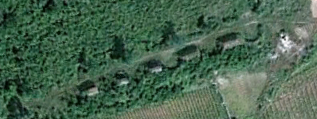As I have mentioned before, North Korea is the most militarized country on Earth. They spend 20% of their GDP on their military (more than 5x higher than the US), males are required to spend 10 years in the military and at any given time 5-10% of their population is on active duty with an additional ~30% of the population in reserves or paramilitary units.
The country has successive layers of defensive positions, most notably around Pyongyang.
This shows the location of many Anti-aircraft artillery sites (AAA) around Pyongyang and their ranges are shown by the circles.
One of the most common AAA platforms is the ZPU-4, pictured below.[1]
(Image source: Commons, CC 3.0)
This is just an example of the weapon and wasn't taken in the DPRK. It has a range of 8km.
There are currently between 1,500-2,000 AAA and HARTS (Hardened ARTillery Sites) sites in North Korea. Due to their economic difficulties and sanctions it is likely that 20-25% of the sites are non-functional (lack of parts, repair capability etc). Although it is very likely that the sites around the capitol and the DMZ are given priority and are functional.
While it is widely agreed that the technology and weaponry used by the DPRK is outdated and would offer little resistance to a full on assault by a modern military the fact that they retain such a vast number of guns and men under arms means that they represent a very real and credible conventional force.[2] Plus, they have special units trained in asymmetric warfare thus any land invasion would be an arduous and costly undertaking.
This realization and the ever-present reality that Seoul, South Korea lies within range of many of the North's weapon systems is why war cannot be considered as a series action. Should a war break out, within 48 hours it is estimated that South Korea could suffer 1 million casualties.[3]
There are two main layouts of their AAA sites and an asymmetrical layout. The most common is the "daisy" or "flower" design.
Here is a smaller version.
This is an example of a linear site. A number of traditionally "daisy" sites have been converted to linear sites.
An asymmetrical site. These are typically located along the thin ridges of low-lying hills or near populated areas lacking in uniform open spaces.
During the 1970's there were many more sites but over the years they have been removed or consolidated. I can only presume that it is because they lack the funding to keep all of them operational and that over the years many of the guns have broken beyond repair. This is one such site.
HARTS are largely a North Korean style of defense. They can take many forms but typically include AAA guns, SCUD missiles, SAM's, radar sites etc located in bunkers either cut into the side of a hill or in hardened facilities. Then they are rolled out into the open to be deployed. Some are also locations with gun positions cut into a hill or berm and are only covered by simple sheds. Although this might not sound all that secure the gun lines are very thin and are backup against a hill with tree cover. This presents a rather small target and depending on time of year they can be hidden rather well from aerial view.
Most of the artillery HARTS (HARTS can also be used to describe underground naval facilities and others) are located along the DMZ and there are 200-500 of them spread out along its 160 mile border. [4]
This is a typical position for the interior of the country.
And here is one typical of the DMZ. Note the small sheds.
Sources:
1.
ZPU-4, Federation of American Scientists
2.
North Korean Military, US Dept. of Defense
3.
From Lambs to Lions, by Thomas Preston, pg 127
4.
HARTS in North Korea, Nautilus Institute
Additional Reading:
Fortress North Korea, from GE user "Planeman_" at Militaryphotos.net
North Korea's WMD programs, Federation of American Scientists
--Jacob Bogle, 3/4/2013
www.JacobBogle.com
Facebook.com/JacobBogle
Twitter.com/JacobBogle












